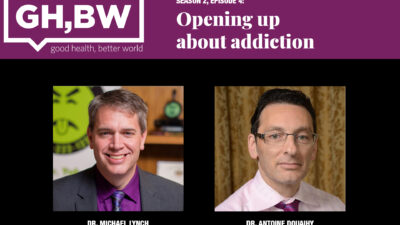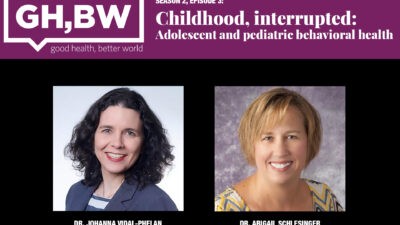Leaders have long worked to use data to try to aid those who seek help from the Allegheny County Department of Human Services, in western Pennsylvania. That effort has ramped up in recent years.
The agency administers child protective services, offers help for those with disabilities, and offers a variety of other programs to help low-income families meet basic needs.
About one in five Allegheny County residents use the agency’s services.
In Episode 6 of Good Health, Better World, host Eileen Beckjord talks with Erin Dalton, deputy director at the Department of Human Services located in Pittsburgh’s county seat. Erin directs research and evaluation, evidence- based planning and information technology for the department.
Read part of the conversation, here, then listen to the entire podcast.
How do you think about information broadly in the context of social determinants of health, whether it be information that we have to acquire to know for whom social determinants may be a barrier or information to enable people to access services around social determinants of health?
We collect data to run our programs and services, all of which are essentially addressing social determinants of health. That is our core work.
We have done a lot of work to try to integrate data for the purposes of integrating care.
First and foremost, we're collecting information to help people. We've brought together data from various sources, and we return it back to the people who are in the best position to use that. Our clients should be able to get their information so that they can best manage their own care.
But also on behalf of providers, we share that data when people are working directly with that client so that they can also integrate care.

When we talk about social determinants of health, we pretty quickly get to also talking about health equity and in the realm of technology specifically. What are some examples that you've observed where you think technology has created an opportunity to improve health equity?
Theoretically, technology can make access to care much easier. It’s not perfect now. But I think we're working with a lot of partners to try and make it much easier for people to find the kind of care they want. And so people can make their own informed choices about where they want to get support and services, who they want to get them from and how they want to get them.
I think that the thing that I think that the jury is still out on, but we've pursued is using our data and modeling to help our workers make critical decisions. For example, in 2016 we implemented a predictive risk model, to help our child welfare caseworkers make decisions about what moves forward to investigation.
We get about 16,000 calls to the hotline every year. And in some of those cases we know a lot about the family because we’ve had previous experience. Our workers are very well trained workers and they also have very fine-tuned sort of gut feelings about this. And then they made a decision about whether to go (out on a call) or not. We implemented a tool that helps us use the data we already have to help them make those decisions.
So the worker is asked to kind of weigh the current crisis and then use this risk score as a companion to make a decision about whether to proceed. We found that we were making more accurate decisions and we did reduce racial disparities in that decision making. It's not to say that the data doesn't have its own biases, but we can use it to perhaps undo some of the biases that exist in our systems.
Locally and across the country, we know that communities of color are disproportionately affected by negative health outcomes and health inequities. Can we advance our charge towards better health equity if we prioritize the folks who've been traditionally underserved? And second, how can you even get people to engage and trust?
We've long believed that people would rather get services from their neighbors, if you will, and family and community than the government per se. So almost all of our work is done through community-based organizations where we're much more of a funder than we are a provider.
We support people through hundreds of community-based providers, not through our own workers. And so it's not us in this case. And we also hire a lot of people who we've served in the past, if you will.
With all of this work, it requires just a ton of community trust. And if we're unwilling to tell the community what we're doing, we should absolutely not be doing it. So, step one, as you step out and you talk to people about what you're doing and you try to explain the challenges and problems we're trying to solve and how we might solve them and get feedback.
We try to be part of the community, not separate.
Listen to the rest of the conversation on the Good World, Better Health podcast.
Learn more about the Allegheny County Department of Human Services by clicking here.
Learn more about the UPMC Center for Social Impact, by clicking here, or by email at [email protected] to inquire about other partnership opportunities.
This conversation has been edited for clarity and brevity.







